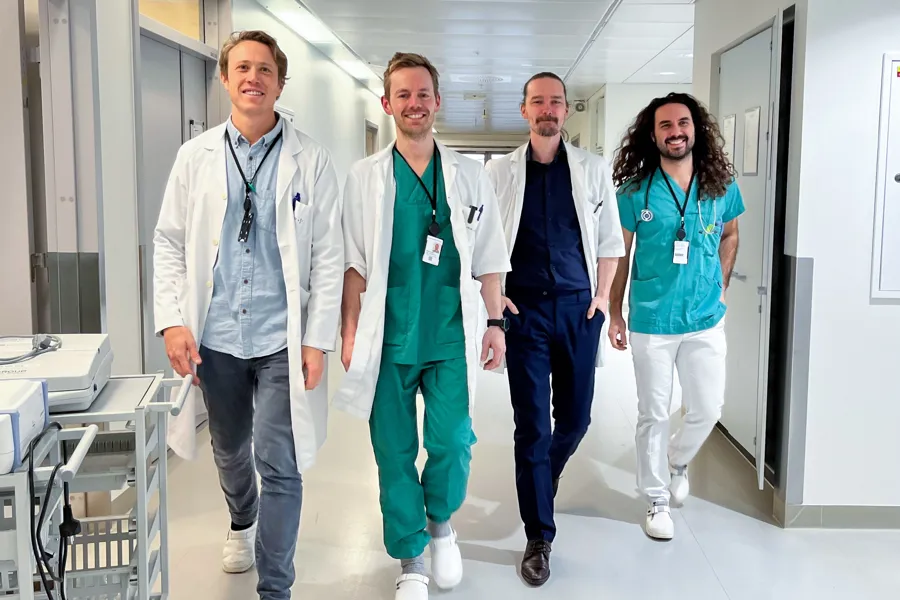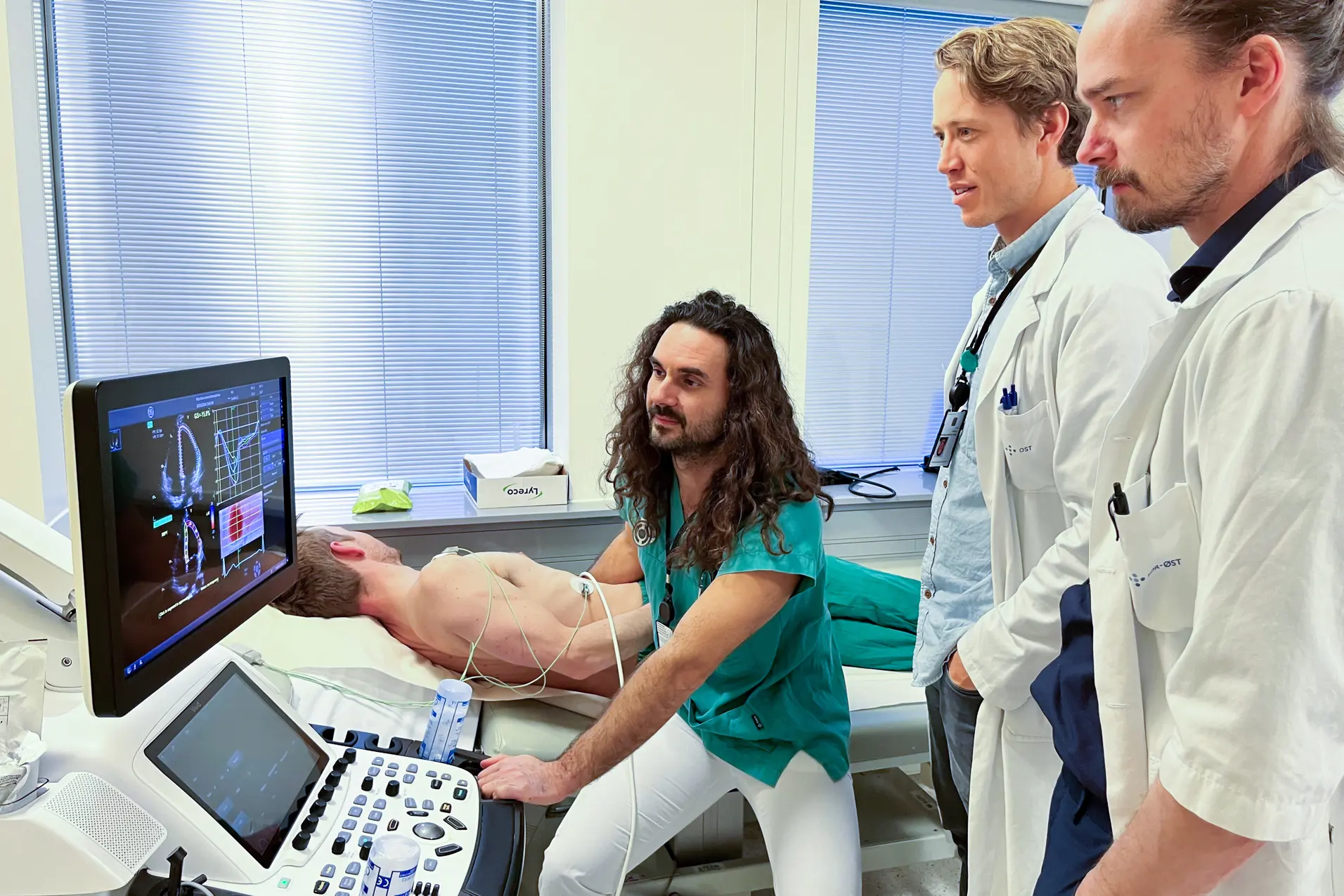Encourages Young Doctors to Work With Clinical Trials
Peder Langeland Myhre, head of the NorTrials centre for cardiovascular diseases, wants to bring more young doctors to work with industry-funded clinical trials. Kristian, Hamza and Tarjei have taken him literally.

- I started working with clinical trials both because there was a need for personnel, but also for my own learning, says Tarjei Øvrebotten (39).
Both he and his two colleagues work in the cardiology department at Akershus University Hospital (Ahus), where Myhre is a senior physician. They are experienced doctors and researchers, but are quite new to trials initiated by the pharmaceutical industry. Tarjei finished medical school in 2015 and has worked at Akershus University Hospital since then. Kristian Berge (38) finished medical school in 2014. He has worked a year in the internal medicine department at Amstellend Hospital in Amsterdam and for a year as a researcher at Radboud UMC in Nijmegen, The Netherlands. In the recent years he has worked - and researched - at the cardiac medicine department at Ahus.
Industrial trials are a new experience
- I did my doctorate here at the department and worked closely with Peder, so taking part in trials he is working on, which are related to my research, came quite naturally. What is exciting about industrial trials is that the path from trials to actual changes in guidelines is often very short. You feel you are taking part in something that can actually change clinical practice, says Berge.
Hamza Nahoui (37) has his medical education from Damascus in Syria and finished medical school there in 2009. When he came to Norway in 2010, he spent a few years learning Norwegian and at the same time getting his medical education approved here. In 2014, he started as LIS 1 in internal medicine in Kristiansund, and stayed there for 7 years, before joining the cardiology department at Ahus in 2022.
- I thought it was quite different to work with large industry-funded trials compared to doing PhD studies. It helped me to see the nuances. In some areas it was an awakening; industrial trials are much more professional and organised, however focus is usually on the effect of a single drug, while researcher-initiated studies often look for associations, connections and predictions of conditions and diseases, says Nahoui.
- Grateful for the important work they do
The young doctors spend 1-7 hours each week working on clinical trials, and much of the time is with patients. In addition, participation in each new trial requires that they undergo a time-consuming authorization process, which involves both e-learning courses and travel activities.
Senior doctor and centre manager Myhre greatly appreciates their efforts.
- I am incredibly grateful that in their busy workday they prioritize contributing to the clinical trials. It can feel insignificant when you are one of many sites in the world, and perhaps include 3 out of 17,000 patients. They don't get their name on scientific articles and they don't get paid extra. But I think it still provides an invaluable lesson in how research is carried out at the highest level - in terms of precision, data collection, privacy etc. They will benefit from this when planning and carrying out their own trials. And by working with international trials now, they get to establish a network with the most skilled doctors in the field, which they can benefit from throughout their career, says Myhre.
Decisive with a management that sees the value
All three of his colleagues can imagine working with industry trials in the future as well, but that depends, among other things, on the hospital management and whether there is enough time.
- I can absolutely see myself working with trials in the future. The role I have now gives me useful experience, without having to spend a lot of my free time on it – thanks to good organization in the department. If you have a percentage of the position set aside for clinical trials, it can provide a certain degree of flexibility in everyday life, which is rare for a hospital doctor. It also gives an advantage if you want to apply for a PhD position or other jobs, says Øvrebotten.
Berge says a lot depends on the management.
- With Henrik Schirmer, Peder Myhre and talented research nurses at the forefront here in the department, it's just great to be involved. If we hadn't had them, I don't know if I would have worked with this, he says.
Difference between large and small hospitals
Nahoui also reminds that there is a difference between university hospitals and local hospitals.
- It is not unusual that in smaller hospitals there is far less activity on clinical trials. There are fewer specialists there, so it is quite natural. But if the conditions are right, it is certainly something I would recommend more people to try, says Nahoui.
Peder Myhre can confirm that much depends on the management.
- I want to pay tribute to the cardiology department here at Ahus, because there is great goodwill in the management to facilitate participation in trials. That is impressive in itself, as there is an insane amount of pressure on clinical operations here. The NorTrials initiative has also been very important. The fact that Ahus got the NorTrials centre for cardiovascular diseases has led to a more positive attitude towards industry trials. And in order for Norway and NorTrials to succeed in attracting more industry-funded clinical trials, we depend on people like Kristian, Tarjei and Hamza, who are out among the patients in the clinic, can do screening, follow-up and contribute to the recruitment of patients for new trials, says Myhre.

May be financial advantages
He emphasizes that there are financial advantage for the individual department to participate in trials.
- If you first set aside time for this, you will be paid for the work through the trials in the long term. For example, if two clinicians each spend 50% of their time on a trial, that can generate funds to hire a third clinician. But the payment comes some time after initiation of the trials, so it's a matter of getting over the first threshold financially, and have the guts to take the risk, says Myhre.
He also reminds us of the most important thing of all: that research can contribute to improving patients' quality of life and prognosis.
- The research is significant, even if the contribution from each individual centre may feel small. It can help change the lives of hundreds of thousands of people by hopefully finding new and effective treatment. It has also been seen that the centra participating in trials are better at adopting new treatment when it comes on the market, which also benefits the patients in the long run, he says.
- An important job for future investigators
Signe Øien Fretland, head of NorTrials coordinating unit, believes that the NorTrials centre for cardiovascular diseases is doing an incredibly important job in involving younger doctors in their clinical trials.
- With limited teaching at medical school in this field, newly qualified doctors are at the mercy of having an environment around them - with enthusiasts like Myhre - to build up competence and experience. Together with a well-organized organization at Ahus, with, among other things, shared positions between clinic and research, this is crucial for training tomorrow's investigators, says Fretland.